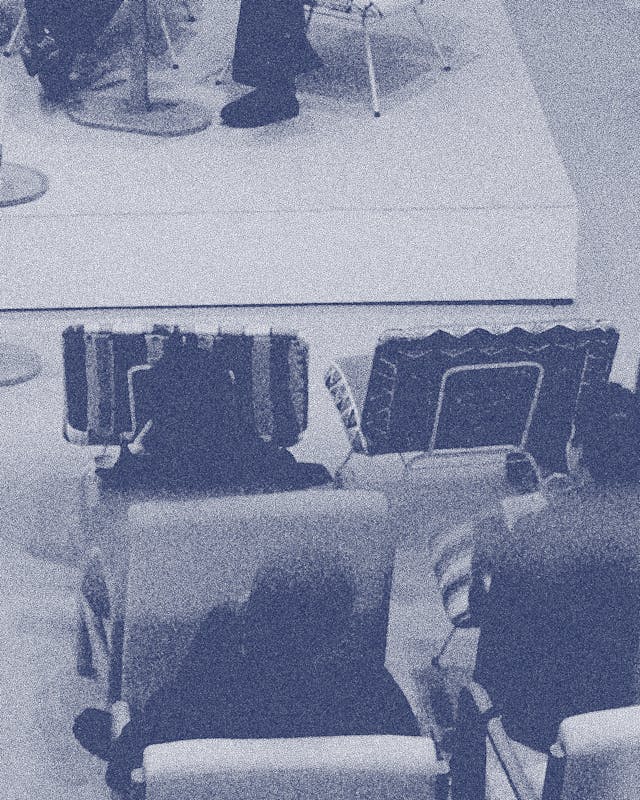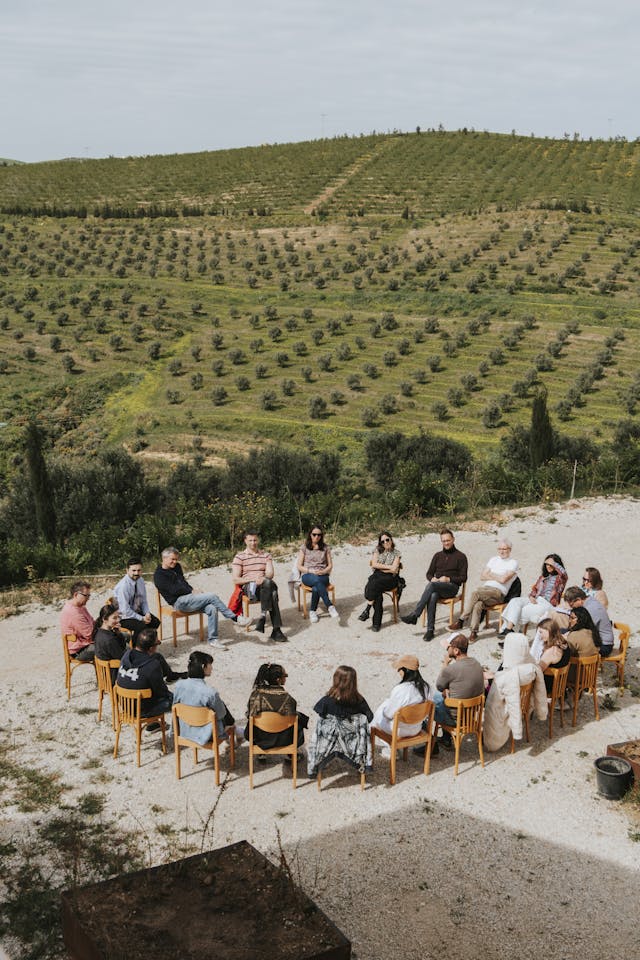Earlier this year, we were invited to take part in Ibraaz’s first Mission Gathering at Mortimer Street. Understandably, much of the conversation focused on the implications of opening an institution that will platform, promote, and support art and culture from a region where conflicts with global consequences are playing out, and where a people’s mere existence is being met with acts of genocide. It is likely, too, that Ibraaz’s mere existence will be understood or received as inherently political. Regardless of intent, its presence will carry political weight and will elicit assumptions as well as expectations – navigating this requires forethought, which Lina and the team have undoubtedly undertaken.
While we care deeply about these matters, we also felt – given the backgrounds and experiences of the other respondents – that we weren’t necessarily the most equipped to talk about them. Instead, we raised a different set of concerns: ones drawn from our own extensive experience working for and with cultural institutions, because as much as Ibraaz will be shaped by external factors and pressures, it will also shape the working lives of those inside it – its staff.
Our contribution ended up taking the form of a list of questions and provocations, shared below in a revised and expanded format. They are not demands, but prompts – some may seem like common sense, or feel self-evident. We wish that were the case. Others are more speculative or aspirational. We don’t expect Ibraaz to meet every one of these points, nor to do so in ways that satisfy everyone. Our intent is to foreground the internal systems that shape public experience: contracts, roles, departmental structures, and labour conditions.
The points below are not only the product of our time spent working in museums and galleries, but also of broader experiences in hospitality, education, freelancing, gig work, political movements and more. Throughout these, a recurring theme we've encountered is the mismatch between the number of managerial positions and the number of people actually suited to leadership – not due to individual failings, but because of a structural imbalance in how organisations define an employee’s progression.
We think often about a friend of ours, a nurse in a critical care unit in Manchester. After several years in her role, she was promoted to Sister – a more senior, managerial position. She stayed in that role for a few months, before returning to nursing. The reason was simple: the promotion meant more administration and less time with patients, which was precisely what drew her to the job in the first place.
In many organisations, progression tends to mean a shift toward administration and oversight – often at the expense of the skills that made someone good at their job in the first place. Managerial progression becomes the default trajectory, even though the skill sets required are completely different. In contrast, one might look to certain corporate models where management is treated more as a horizontal function rather than a position of authority. That separation – between coordination and control – might offer a healthier way of thinking about leadership, which is still very much necessary (‘The Tyranny of Structurelessness’ is a must-read critique of absolute organisational horizontality).1
We hope these points are useful not just to Ibraaz, but to anyone involved in shaping or rethinking how institutions or ventures – in the broadest sense – are designed, and how we can question the inefficiencies of inherited standards.
- Labour Conditions & Employment Ethics
- What salary bands are being proposed for staff, and how are these determined?
- Will the institution adopt a flat wage structure?
- Will any roles be contracted as zero-hours?
- Is a 4-day working week under consideration?
- How much annual leave will staff receive?
- What length of maternity and paternity leave will be offered?
- Will union membership be supported – or encouraged – for staff?
- Will staff be given paid meal breaks, and how long will these be?
- Will the institution commit to paying artist invoices within a clearly defined timeframe? How will it ensure this commitment is honoured?
- Institutional Structure & Internal Culture
- Will the institution operate with a distributed leadership model such as co-directors, rotating chairs, or flat collectives?
- Will the internal structure incorporate degrees of horizontality, with staff-as-generalists rotating between functions?
- Can an institution maintain non-hierarchical structural aspects while functioning within external systems that are hierarchical, like funding bodies, grant structures, or legal frameworks?
- How fixed will roles and responsibilities be within the institution? Might they be assigned on a project-by-project basis?
- What is the institution optimising for? How are its mission, vision, and values being defined to reflect those priorities – whether cultural, operational, or political?
- How will success be defined and measured? Are there qualitative KPIs that balance out quantitative ones? Ben Davis’s text on ‘quantitative aesthetics’ is a great read regarding the pitfalls of data as a tastemaking function.2
- How can staff have a sense of ownership and participation in the institution’s direction—and what incentives support that?
- Will staff be encouraged to grow within their roles? For example, if front-of-house staff want to contribute to programming, are there pathways for them to do so?
- Would the institution consider having a 1-year fixed contract specifically for recent graduates – with a focus on development, mentorship, and CV-building?
- Will cleaning duties be handled in-house by one – or multiple – people, or will they be outsourced?
- Will there be a dedicated front-of-house team and if so how will their responsibilities be defined?
- Where will the front-of-house team sit within the institutional hierarchy? Will they be subordinate to the ‘back office’?
- What level of operational visibility and participation will front-of-house staff have across other areas of the institution?
- For staff invigilating galleries, what expectations will be set around interaction with visitors? Will they be permitted to read, or to use their phones or laptops?
- How will the institution prepare staff to navigate difficult or contentious conversations with visitors?
- What internal structures will support the resolution of conflict or disagreement among staff?
- If horizontal structural aspects were adopted, how would accountability and conflict resolution be handled in the absence of traditional managerial hierarchies?
- What forms of oversight or collective input will guide the institution – a board, a local assembly, an advisory council, or something else?
- Technology & Infrastructure
- Even if not explicitly tech-centric, could the institution implement back-end technologies – such as collaborative decision-making tools or shared knowledge systems – to support alternative approaches to governance, archiving, or access?
- What platforms – such as a podcast studio or Discord server – could support community and ecosystem building?
- Could AV production facilities be made available to residents or collaborators – offering tools as part of the institution’s infrastructural support?
- Access, Hospitality & Everyday Use
- Will the institution function as a warm bank, even if unofficially?
- Will people be able to co-work in the café, using it as an informal public space?
- Will there be an education programme for school groups?
- Will there be a dedicated space for hands-on or messy activities?
- Will the institution offer affordable activities for children during school holidays?
- Will there be a dedicated time or space for new parents?
- Will there be provision for visitors with additional needs, such as autism – for example through adjusted timings or sensory-friendly environments?
- Will screenings be offered in multiple languages?
- Will exhibition materials be available in multiple languages or formats, such as braille?
- Will creative access consultants be involved in any modifications to the building, and in the planning of events?
- Will the institution adopt a code of conduct for visitors?
- How will the institution position itself in relation to local organisations – particularly in relation to political organising, cross-disciplinary collaboration, and accessibility?



